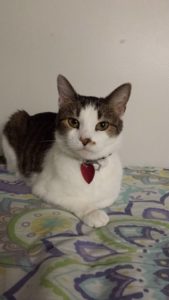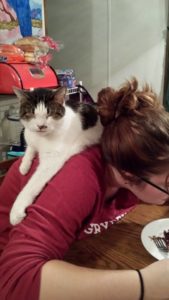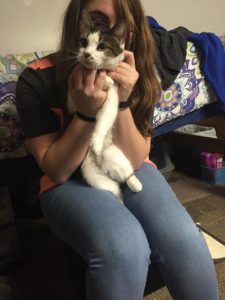Writer Feature: How Adopting a Pet Benefitted My Life

Editor’s Note: Please welcome to our writer roster Cheyenne Cooley! Cheyenne is the proud mom of Saya and is a Northern Kentucky University student. We are thrilled to have her on board!
Before I was thirteen, I never had a pet of my own. We had family dogs and the occasional bird, but I never had my own furbaby; one that I could name and take care of on my own. When I turned thirteen and I had the opportunity to give a kitten a new home, one that might have otherwise been put in a shelter or just put out as a stray, I jumped on it.
A f riend that I played softball with had a cat who had just had a litter of kittens and she invited me to come get first pick of the litter. My mother didn’t want me to get a boy because they were louder in her experience, but I didn’t care. If that’s all she had, that’s what I was getting. When I arrived and got to see all of the kittens just running around and playing, I saw one that I immediately fell in love with. She was mostly white, with black and grey on her head and back, almost making a little hat and cape across her body. She had the prettiest green eyes with flecks of brown and orange in them. When she looked at me, she was mine. She came right up to me and just looked at me as if she’d been waiting for me. I had to take her home. The little kitten was so quick, so I named her Saya, which meant swift arrow in Japanese–because of course I was in an anime phase. The name still fits her, but she also gets called “babygirl.”
riend that I played softball with had a cat who had just had a litter of kittens and she invited me to come get first pick of the litter. My mother didn’t want me to get a boy because they were louder in her experience, but I didn’t care. If that’s all she had, that’s what I was getting. When I arrived and got to see all of the kittens just running around and playing, I saw one that I immediately fell in love with. She was mostly white, with black and grey on her head and back, almost making a little hat and cape across her body. She had the prettiest green eyes with flecks of brown and orange in them. When she looked at me, she was mine. She came right up to me and just looked at me as if she’d been waiting for me. I had to take her home. The little kitten was so quick, so I named her Saya, which meant swift arrow in Japanese–because of course I was in an anime phase. The name still fits her, but she also gets called “babygirl.”
Today, Saya is seven years old and she is something special. Whenever I’m sad, sick, or angry, she always knows when to snuggle and her purring when I pet her always makes me feel better. We always used to play together, I would spoil her with treats, and she would sleep either on my chest or on my pillow every night. When I had to go off to college, we were both heartbroken and lonely. I decided to attend Northern Kentucky University, my first choice, but it is a steep two hour drive from my hometown so I couldn’t go visit Saya whenever I wanted. The first year and a half, I didn’t even have
a guaranteed way to go home. When I was home, Saya was extremely clingy and a huge cuddler–not that I’m complaining. However, according to my mother, when I was gone at school Saya would sit at the door waiting for me to come back and she was even more antisocial than before. My end wasn’t much better. I probably cried every day during freshman year, and sophomore year about once a week. I couldn’t handle being so homesick and when you throw my anxiety and depression diagnosis on top of all of that, I just needed my cat.
I saw on Instagram between freshman and sophomore year that a friend of mine was getting a bunny as a service animal, so I started talking to my counselor about if that would be possible for me. She had to write a letter for me and I had to register with housing and disability services, but starting the second semester of sophomore year, Saya moved up to NKU with me as an emotional support animal. She and I both got so much better. I could actually sleep and she was a little more social. There were a lot less tears and a lot more snuggle sessions with my beautiful cat.
 Emotional support animals are a special kind of service animal. They don’t require special training, and can be any kind of animal. Not only does the animal already have a special bond with you from being your pet for any amount of time, but I think the activity of taking care of another living thing is very calming. If my cat gets sick, I am focused on taking care of her and making sure that she’s okay. She’s a very good distraction, and she has improved my college experience.
Emotional support animals are a special kind of service animal. They don’t require special training, and can be any kind of animal. Not only does the animal already have a special bond with you from being your pet for any amount of time, but I think the activity of taking care of another living thing is very calming. If my cat gets sick, I am focused on taking care of her and making sure that she’s okay. She’s a very good distraction, and she has improved my college experience.
Adopting Saya changed my life for the better. Not everyone qualifies for an emotional support animal, but adopting a pet can definitely contribute to the health and happiness of anyone. For more information on emotional support animals, check out animallaw.info and Chris Ligatti’s paper on emotional support animals.

